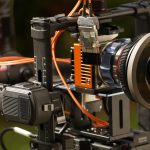The 9×7 Digital Cinema Camera is not just about ultra-high resolutions, although it can out-resolve multi-camera arrays consisting of 4~6 high end digital cinema cameras and 15-perf 70mm IMAX film.
The 9×7 is also about colour range and accuracy. How come?
The 9×7 starts with high-quality CFA (colour filter array) with exceptionally good discrimination and rejection of unwanted spectra. Unlike most CFAs, these high quality filters do not exhibit much cross-talk between primaries and magenta line (duo-chromatic fully saturated colours that lie between deep blue and deep red on CIE Chromacity chart) is extremely clean with virtually no contaminations from near-UV, or near-IR. This means deeper saturated colours, and more precise reproduction of subtle hues and gradations, such as skin tones. For accurate colour reproduction this is crucial because, if CFA doesn’t discriminate colours properly (say two different hues end up with same or very similar RAW RGB values), there is no magic in the colour science that can possibly make those colours appear different or accurate downstream.
But, while ground-breaking, this colour-rich raw data is not even the most exciting thing about 9×7 colour reproduction. Out of the box, the 9×7 offers factory calibrated colour profile (colour science allowing interpretation of raw values). This is what all other camera makers offer too. But here, we are not a “me too” company. We also offer sophisticated, yet very easy to use, Direct Scene-Referred (DSR) workflow allowing not just perfect colour reproduction in perfect lighting conditions, but virtually any lighting conditions. The cinematographer can capture colour science in-situ on set and attach any clip, so it travels through the entire colour processing pipeline with superior and consistent results.







